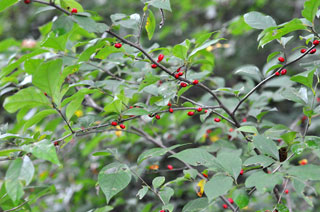SPICEBUSH
|
 |
| File Size: 101 KB |
|
|
|
Lindera benzoin (L. ) Blume
|
| Wildcat Glades Conservation & Audubon Center, Newton County, Missouri |
| Height: 5-14 feet |
| Family: Lauraceae - Laurel Family |
| Flowering Period: April |
|
| Trunks: | | Single, much branched; branches usually low; bark light grayish-brown, smooth; lentils raised. | | Twigs: | | Gray green to brown, glabrous or pubescent, spice-like fragrance when broken; lenticels vertical, conspicuous; leaf scar half-round; bundle scars 3. Buds single or clustered, greenish-brown, ovoid; one leaf bud near leaf scar, flower buds slightly above it. | | Leaves: | | Alternate, simple, deciduous, strongly aromatic; petiole .4 to .5 inch; blade elliptic to obovate, 1.6 to 6 inches long, .8 to 2.4 inches wide, pinnately veined, base wedge-shaped, margins entire, often ciliate, tip short acuminate to rounded, upper surface dark green, glabrous, lower surface pale, glabrous to pubescent. | | Flowers: | | Appear before the leaves, dioecious. Staminate flowers in dense, nearly sessile clusters from buds of previous year, calyx lobes 6, yellow, obovate, 1/10 to 1/8 inch, tips fringed; corolla absent; stamens 9, one opposite each calyx lobe plus an inner row of 3 each with pair of yellow stalked glands at base; filaments greenish; anthers yellow. Pistillate flowers in clusters on wood of previous year; calyx lobes 6, yellow, oblong to ovate, ca. 1/10 inch, corolla absent; staminodes 12-18; ovary green, ovate; stigma brownish, capitate. | | Fruit: | | September; drupe, solitary or in clusters of 2-4, bright red, oblong, 2/5 to 1/2 inch long, 1/4 to 1/3 inch thick, smooth, glossy, ends blunt, 1-seeded, strongly aromatic; seed ellipsoid to ovoid, brownish with dark blotches. | | Habitat: | | Stream and river banks, low, moist woods, thickets, ravine bottoms, margins of wetlands; often in rich, moist soils | | Distribution: | | Southeast corner of Kansas | | Origin: | | Native | | Uses: | | The fruits are eaten by migratory birds. Native Americans took decoctions or infusions of twigs and leaves for colds, coughs, measles, and to induce perspiration for aches and pains. A tea-like beverage was made from the leaves and twigs. According to Steyermark, the fruit was dried and powdered and used as allspice substitute during the Revolutionary War. | | Comments: | | Perennial understory shrub. The wood is soft and greenish-yellow. All parts of this shrub have a strong spice aroma. Lindera honors Swedish botanist Johann Linder, 1676-1723. |
|
| Spicebush |  | | 130 KB | | Wildcat Glades Conservation & Audubon Center, Newton County, Missouri |
| | Spicebush |  | | 116 KB | | Wildcat Glades Conservation & Audubon Center, Newton County, Missouri |
| | Spicebush flowers |  | | 28 KB | | Wildcat Glades Conservation & Audubon Center, Newton County, Missouri |
| | Spicebush flowers |  | | 41 KB | | Wildcat Glades Conservation & Audubon Center, Newton County, Missouri |
| | Spicebush flowering |  | | 52 KB | | Wildcat Glades Conservation & Audubon Center, Newton County, Missouri |
| | Spicebush leaf |  | | 64 KB | | Wildcat Glades Conservation & Audubon Center, Newton County, Missouri |
| | Spicebush |  | | 103 KB | | Wildcat Glades Conservation & Audubon Center, Newton County, Missouri |
| | Spicebush buds |  | | 30 KB | | Wildcat Glades Conservation & Audubon Center, Newton County, Missouri |
| | Spicebush buds |  | | 33 KB | | Wildcat Glades Conservation & Audubon Center, Newton County, Missouri |
| | Spicebush fruit |  | | 71 KB | | Wildcat Glades Conservation & Audubon Center, Newton County, Missouri |
|
|
|
|